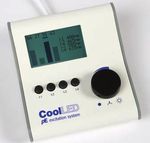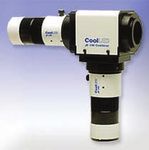Microscope illumination: the LED revolution - GAZETTE OF THE INSTITUTE OF BIOMEDICAL SCIENCE - CoolLED
←
→
Page content transcription
If your browser does not render page correctly, please read the page content below
www.ibms.org February 2011
GAZETTE OF THE INSTITUTE OF BIOMEDICAL SCIENCE
Microscope illumination:
the LED revolutionARTICLE MICROSCOPY
Microscope illumination:
the LED revolution
and this leads to uneven illumination over
Light-emitting diode products are set to replace conventional discharge the microscope’s field of view. In addition,
bulb lifetime is just a few hundred hours.
and incandescent lamps to provide more simple, cost-effective and The metal-halide lamp is an enhanced
version of the high-pressure mercury lamp.
environmentally-friendly alternatives. Here, James Beacher summarises It provides more stable illumination and has
a longer bulb lifetime. It does, however, suffer
current microscope illumination and looks at LED developments. from degradation in performance during the
bulb lifetime (around 2000 hours) and is
more expensive to purchase. As it produces
The use of microscopes in hospitals and consideration given to the convenience, ultraviolet (UV) light, the liquid light-guide
laboratories covers a very wide spectrum safety, environmental and reduced operating used to deliver light from the unit to the
of applications, from the identification of costs of new LED-based products. microscope also needs to be replaced
fungal mycelium in a clinic to the screening regularly.
of cervical preparations for premalignant INCANDESCENT AND A less-common option for fluorescence
change in cytopathology, and the DISCHARGE LAMPS is the xenon lamp. This exhibits a flatter
identification of acid alcohol-fast bacilli If you use a microscope in your laboratory it is intensity across the light spectrum, which
(AAFB) in microbiology. Such procedures likely that it will have illumination fitted using makes it more suitable for quantitative
make use of different microscopy techniques one of the common lamp types summarised analysis.
including conventional brightfield below. Probably the most common type of
(transmitted light), phase contrast (DIC) microscope illuminator overall is the halogen BENEFITS AND DISADVANTAGES
and fluorescence techniques. lamp. This is suitable only for transmitted OF CONVENTIONAL LAMPS
Historically, illumination has been light applications due to its low intensity. The conventional lamps referred to above
provided by a range of conventional It is also relatively inefficient and can exhibit have the benefit that they produce a broad
incandescent or discharge lamps. They can be a shift in colour temperature with time. spectrum of white light that can be used
classified as halogen (also tungsten-halogen), For fluorescence microscopy, the high- for most applications. In fluorescence
xenon, mercury (also known as an HBO pressure mercury vapour arc-discharge lamp microscopy, the user simply changes the
or a UV burner) and metal-halide. In recent is most common. This is significantly more microscope filter cube to match the stain
years, light-emitting diode (LED) illumination powerful than other forms of lamp but its (eg auramine or acridine) and then has the
products have become available and offer intensity varies across the light spectrum. appropriate illumination configuration.
many exciting benefits. It is hampered by poor spatial homogeneity However, conventional lamps suffer
In this article, the different types of due to its complex construction and various significant drawbacks. They generate
illumination available are reviewed, their alignment requirements. Therefore, unwanted heat, are inefficient and require
benefits and disadvantages identified, and replacement bulbs can be difficult to align regular bulb replacement. In addition, many
of these lamp types also use mercury, which
is a recognised hazardous material.
120 A warm-up period and cool-down period
is also required before and after use, which
100
>10,000 hours
is inconvenient. As a result, they are often
Intensity (%)
80 for LEDs kept switched on throughout the day in order
LED to be available when required. As they are
60 inefficient, energy is wasted and unwanted
Metal-halide
40 heat is generated. The bulbs have a limited
Mercury operating life and their performance reduces
20 over that period (typically from a few hundred
to a few thousand hours).
0
Conventional lamps also produce UV
0 1000 2000 3000
Time (hours) light, which often is not required to study the
sample. This UV light can bleach stained
Comparison of stability and lifetime of different light sources. samples and also kill live cells, which reduces
2 THE BIOMEDICAL SCIENTIST REPRINTED FROM FEBRUARY 2011ARTICLE
the amount of time that they can be examined. ENVIRONMENTAL CONSIDERATIONS
Intensity from a conventional lamp There are three main areas where microscope
decreases through its life. Most lamps are illumination is affected by environmental
quoted with a lifetime to 50% of original considerations: 1) health and safety
intensity, which means that illumination varies considerations relating to eye damage from
dramatically over time. Thus, quantitative or UV radiation, 2) the safe use and disposal
comparative measurements are not possible of mercury products, and 3) ‘green’ aspects
unless a new bulb is used on every occasion. of reduced energy consumption.
Ultraviolet light is known to damage the
LIGHT-EMITTING DIODE human eye. Broad-spectrum incandescent or
ILLUMINATION discharge lamps generate a lot of unwanted
With the introduction of LED-based UV light which needs to be filtered out. These
microscopy illumination, almost all of the lamps are safe when fitted to microscopes
disadvantages of conventional incandescent that have a UV filter installed to reduce this
and discharge lamps are overcome. Light- risk. Care must be taken when operating
emitting diodes are solid-state semiconductor the lamp if no filters are in place or when it
devices that emit light directly without using is not fitted to the microscope. As LEDs only
a bulb. Previously used only as indicators, An array of LEDs for increased generate the desired wavelengths of light,
LEDs are now sufficiently intense to be used performance, with, inset, a single LED only those with specified illumination in the
to illuminate. Their potential in consumer die showing the brightness achievable. UV region can cause UV damage
applications is making them ubiquitous in Intensity on the surface of an LED can Where mercury is used, consideration
markets such as the automotive industry and be as much as 70 W/cm2. must be given to risk of the bulb exploding,
in lighting for buildings. and the release of mercury vapour into the
Light-emitting diodes can be up to five 50,000 hours now being offered, so LED air. Health and safety requirements for
times more efficient than a conventional illuminator lifetime can now be expected to mercury can be onerous as it is a recognised
incandescent or discharge lamp. As a result, be 10 or even 20 years! This amounts to a hazardous material. There are also strict rules
considerable development has been carried significant financial saving against the cost for the safe disposal of spent mercury bulbs.
out, both by the LED-chip manufacturers to of purchase, alignment and disposal of the Laboratories are being encouraged to
increase brightness and by the end-product equivalent conventional bulbs required over reduce their energy consumption. With the
manufacturer to engineer specialised this period. higher efficiencies offered by LEDs, up to
packaging, thermal management and optics As LEDs produce narrow wavebands five times less energy is consumed during
dedicated to end-user applications. Together, of light, consideration must be given to the comparable usage. As many conventional
these improvements have now resulted in correct filter cube and stain excitation region. lamps are left on all day to overcome the
LED illumination systems that provide greater Optically misaligned or poorly performing warm-up requirements, the actual reduction
intensity than incandescent lamps in regions filters can reduce performance considerably. in energy by using instant on/off LEDs can
of the spectrum important for microscopy. The LED intensity can be greater than be significant.
As intensity has increased, the additional mercury lamps (100 W) in the blue and
benefits offered by LEDs have become very red excitation regions but are weaker than DEDICATED AND GREEN
attractive. These are instant on/off capability, mercury in the green excitation (red Conventional incandescent and discharge-
long lifetime, low running costs, greater emission) region. lamp illumination offers the benefit of
efficiency and less heat generated. As LEDs are more efficient, less energy broadband illumination. This reduces
is used and less heat needs to be dissipated, the need to consider optical filtering and
BENEFITS AND DISADVANTAGES which can be an important issue if the a single light source can satisfy most
OF LIGHT-EMITTING DIODES microscope is being used in close or cramped microscopy applications. However, they are
When one considers that the LED can be conditions. They exhibit greater stability and inconvenient to use and require regular
switched on/off instantly, the amount of actual repeatability, which makes comparative tests, bulb replacement.
‘on’ time in a day can be measured in a few or tests against a reference sample, more Light-emitting diodes are set to replace
hours, and thus intensity remains broadly the reliable. With their instant on/off capability, incandescent and discharge lamps due to
same over its lifetime, with 10,000 or even LEDs can act as a shutter, saving additional their improved intensity, long lifetime and
costs on the microscope. ease of use; however, greater consideration
The LED can produce white light with must be given when selecting wavelengths
a fixed colour temperature. This can be and optical filters to optimise performance.
achieved using either a blue LED with a For many defined applications, such as the
phosphor overlay to shift the light (as used use of auramine, acridine, Calcofluor and
in most consumer products) or by combining FITC, dedicated LED illumination offers
LEDs with red, green and blue wavelengths only benefits.
(as a television picture is generated). The environmental and safety benefits
Furthermore, the ability to tune the colour of LEDs are also persuasive. No mercury is
is possible. used and no replacement and disposal issues
Applications for illumination requiring need to be addressed. Finally, lower power
a single LED wavelength are perfect for consumption satisfies the ever-increasing
clinical screening. Fluorescence microscopy demand for a ‘greener’ laboratory. r
lends itself to illumination by a specific
colour. In fact, auramine, acridine and Further information is available from
fluorescein isothiocyanate (FITC) can all be the author, Jim Beacher, CoolLED,
With instant on/off capability and 0–100% illuminated using a single 470 nm LED light CIL House, Charlton Road, Andover,
intensity adjustment, LED illumination offers source, and there are now LED colours for Hants SP10 3JL (tel +44 [0]7887 750496,
convenience and control. No warm-up or most common fluorophores used for all email jim.beacher@coolled.com).
cool-down time saves on energy costs. fluorescence applications.
REPRINTED FROM FEBRUARY 2011 THE BIOMEDICAL SCIENTIST 3Including:
Replace your Mercury lamp with a pE-100 LEICA
LEITZ
Select the single wavelength pE-100 to match your fluorophore and test MOTIC
Fits all NIKON
Examples of tests using the CoolLED pE-100 microscopes OLYMPUS
MYCOBACTERIA
ZEISS
A typical test would be for
BACTERIOLOGY tuberculosis (TB), and other Most microscopes, old and new,
are compatible with CoolLED’s
acid fast bacilli (AFBs). pE-100 series LED illuminators.
A typical test would be for
Trichomonas vaginalis. For testing with Auramine A current list of microscope
stains select a pE-100 at fittings can be found on our
For testing with website. Contact CoolLED with
470nm. (Similar staining details of your microscope if you
Acridine Orange select cannot find a suitable fitting on
can also be used for
a pE-100 at 470nm the list.
cryptosporidium)
MYCOLOGY YOU CAN COMBINE
VIROLOGY
A typical test TWO pE-100s FOR
A typical test would be would be for fungal MULTIPLE TESTING
for RSV or parainfluenza. mycelium/elements.
For testing For testing with
with Fluorescein Calcofluor White select
Isothiocyanate a pE-100 at 400nm*
(FITC) select a
pE-100 at 470nm *Also available at 365nm
as required
Contact us with details of your test and For more information on how
we can advise a suitable pE-100 unit CoolLED products can help you,
contact us now:
info@CoolLED.com
+44 (0)1264 320989 (Worldwide)
1-800-877-0128 (USA Toll Free)
www.CoolLED.comYou can also read























































